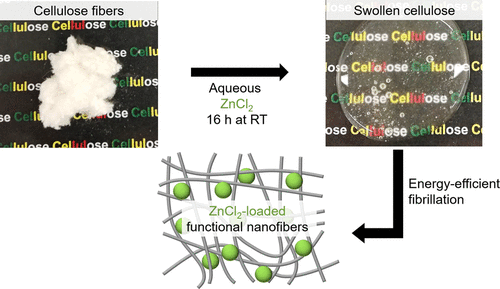当前位置:
X-MOL 学术
›
ACS Sustain. Chem. Eng.
›
论文详情
Our official English website, www.x-mol.net, welcomes your
feedback! (Note: you will need to create a separate account there.)
Partial Amorphization of Cellulose through Zinc Chloride Treatment: A Facile and Sustainable Pathway to Functional Cellulose Nanofibers with Flame-Retardant and Catalytic Properties
ACS Sustainable Chemistry & Engineering ( IF 7.1 ) Pub Date : 2020-08-24 , DOI: 10.1021/acssuschemeng.0c03492 Dennis Burger 1 , Armin Winter 2 , Guruprakash Subbiahdoss 3 , Josua T. Oberlerchner 4 , Marco Beaumont 4 , Yasushi Tamada 1 , Thomas Rosenau 4, 5
ACS Sustainable Chemistry & Engineering ( IF 7.1 ) Pub Date : 2020-08-24 , DOI: 10.1021/acssuschemeng.0c03492 Dennis Burger 1 , Armin Winter 2 , Guruprakash Subbiahdoss 3 , Josua T. Oberlerchner 4 , Marco Beaumont 4 , Yasushi Tamada 1 , Thomas Rosenau 4, 5
Affiliation

|
This work established an energy-saving and straightforward treatment of cellulosic pulp to obtain functional cellulose nanofibers equipping them at the same time with catalytic activity and flame-retardant properties. For this purpose, dried cellulose pulp was mixed with a recyclable swelling agent, ZnCl2 hydrate, at room temperature. The mild treatment affected the crystal structure through a partial amorphization, yielding a mix of native cellulose I and regenerated cellulose II. This treatment tremendously facilitated the fibrillation into a cellulose nanofiber (CNF) network. In comparison to fibrillated cellulose from nontreated pulp, the ZnCl2-treated counterpart featured higher viscosity, film transparency, better mechanical properties, and higher heat stability. Films produced from these nanofibers showed flame-retardant properties without any further modification. The ZnCl2–CNF showed also high reactivity in fiber surface acetylation and allowed a fast and efficient reaction while using very mild conditions. All in all, we propose a simple and resource-efficient cellulose treatment to obtain a nanostructured cellulose. These nanofibrils are decorated with ZnCl2 which imposes flame-retardant properties and confined catalytic activity at the fibril surface.
中文翻译:

通过氯化锌处理纤维素的部分非晶化:具有阻燃和催化性能的功能性纤维素纳米纤维的一种简便且可持续的途径
这项工作建立了纤维素纸浆的节能,直接处理方法,从而获得功能性纤维素纳米纤维,该纤维同时具有催化活性和阻燃性能。为此,将干燥的纤维素纸浆在室温下与可回收的溶胀剂ZnCl 2水合物混合。温和的处理通过部分非晶化影响晶体结构,产生天然纤维素I和再生纤维素II的混合物。这种处理极大地促进了原纤化成纤维素纳米纤维(CNF)网络。与未处理纸浆的原纤化纤维素相比,ZnCl 2经处理的对应物具有更高的粘度,薄膜透明度,更好的机械性能和更高的热稳定性。由这些纳米纤维制成的膜显示出阻燃性能,而没有任何进一步的改性。ZnCl 2 -CNF在纤维表面乙酰化反应中也显示出高反应活性,并且在非常温和的条件下也可以进行快速有效的反应。总而言之,我们提出了一种简单且资源有效的纤维素处理方法,以获得纳米结构的纤维素。这些纳米原纤维装饰有ZnCl 2,后者在原纤维表面具有阻燃性和有限的催化活性。
更新日期:2020-09-14
中文翻译:

通过氯化锌处理纤维素的部分非晶化:具有阻燃和催化性能的功能性纤维素纳米纤维的一种简便且可持续的途径
这项工作建立了纤维素纸浆的节能,直接处理方法,从而获得功能性纤维素纳米纤维,该纤维同时具有催化活性和阻燃性能。为此,将干燥的纤维素纸浆在室温下与可回收的溶胀剂ZnCl 2水合物混合。温和的处理通过部分非晶化影响晶体结构,产生天然纤维素I和再生纤维素II的混合物。这种处理极大地促进了原纤化成纤维素纳米纤维(CNF)网络。与未处理纸浆的原纤化纤维素相比,ZnCl 2经处理的对应物具有更高的粘度,薄膜透明度,更好的机械性能和更高的热稳定性。由这些纳米纤维制成的膜显示出阻燃性能,而没有任何进一步的改性。ZnCl 2 -CNF在纤维表面乙酰化反应中也显示出高反应活性,并且在非常温和的条件下也可以进行快速有效的反应。总而言之,我们提出了一种简单且资源有效的纤维素处理方法,以获得纳米结构的纤维素。这些纳米原纤维装饰有ZnCl 2,后者在原纤维表面具有阻燃性和有限的催化活性。


















































 京公网安备 11010802027423号
京公网安备 11010802027423号